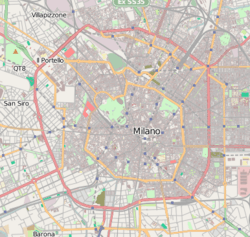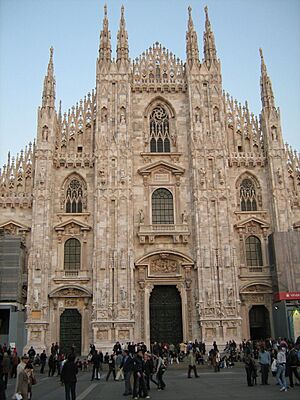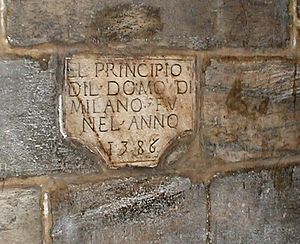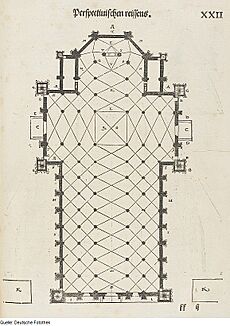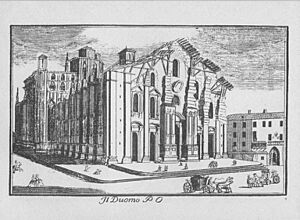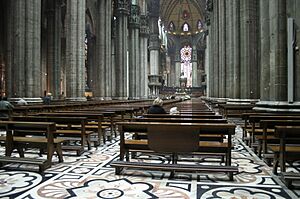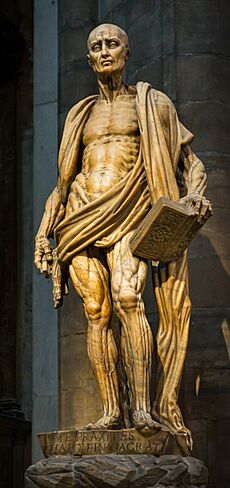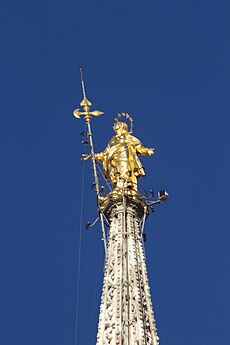Milan Cathedral facts for kids
Quick facts for kids Milan Cathedral |
|
|---|---|
| Metropolitan Cathedral-Basilica of the Nativity of Saint Mary | |
|
Basilica cattedrale metropolitana di Santa Maria Nascente (Italian)
|
|
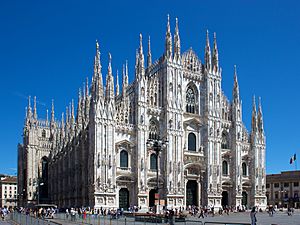
Milan Cathedral from the Square
|
|
| 45°27′51″N 9°11′29″E / 45.46417°N 9.19139°E | |
| Location | Via Carlo Maria Martini, 1 20122 Milan |
| Country | Italy |
| Denomination | Roman Catholic |
| Tradition | Ambrosian Rite |
| History | |
| Status | Cathedral, minor basilica |
| Architecture | |
| Functional status | Active |
| Architect(s) | Simone da Orsenigo et al. |
| Style | Gothic, Renaissance architecture |
| Groundbreaking | 1386 (original building) |
| Completed | 1965 |
| Specifications | |
| Capacity | 40,000 |
| Length | 158.6 metres (520 ft) |
| Width | 92 metres (302 ft) |
| Nave width | 16.75 metres (55.0 ft) |
| Height | 108 metres (354 ft) |
| Other dimensions | Facade facing West |
| Dome height (outer) | 65.6 metres (215 ft) |
| Number of spires | 135 |
| Spire height | 108.5 metres (356 ft) |
| Materials | Brick with Candoglia marble |
| Administration | |
| Archdiocese | Archdiocese of Milan |
The Milan Cathedral (also known as Duomo di Milano) is a huge church in Milan, Italy. It is officially called the Metropolitan Cathedral-Basilica of the Nativity of Saint Mary. This amazing building is dedicated to the birth of St. Mary. It is the main church for the Archbishop of Milan, who is currently Mario Delpini.
Building this cathedral took almost six centuries, which is 600 years! Construction started in 1386. The very last parts were finished in 1965. It is the biggest church in Italy. The even larger St. Peter's Basilica is in Vatican City, which is its own country. Milan Cathedral is the third largest church in the world.
Contents
History of Milan Cathedral
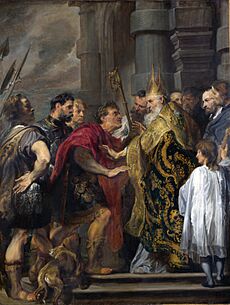
The city of Milan is designed around the Duomo. This shows that the cathedral stands on the most important spot in ancient Roman Milan. This was where the public basilica faced the forum. The first cathedral, called the "new basilica," was finished by 355 AD. An old octagonal baptistery, built in 335 AD, can still be visited under the cathedral. In 1075, a fire damaged the old cathedral. It was then rebuilt as the Duomo we know today.
Starting Construction of the Duomo
In 1386, Archbishop Antonio da Saluzzo began building the cathedral. This happened when his cousin, Gian Galeazzo Visconti, came to power in Milan. The new building was a reward for the people who had suffered under the previous ruler. Gian Galeazzo wanted to show Milan's importance. He also wanted to live in Pavia, not Milan.
Before building started, three old buildings were taken down. These included the Archbishop's palace and the Baptistry of St. Stephen. The old Santa Maria Maggiore church was used for its stones. People were very excited about the huge new building. Gian Galeazzo and the archbishop collected many donations.
The building project was managed by the "Fabbrica del Duomo". It had 300 workers led by the first chief engineer, Simone da Orsenigo. Orsenigo first planned to build the cathedral from brick in the Lombard Gothic style.
New Ideas and Challenges
Gian Galeazzo wanted the cathedral to follow the latest European styles. In 1389, a French engineer, Nicolas de Bonaventure, was hired. He added the Rayonnant Gothic style to the church. Gian Galeazzo gave the Fabbrica del Duomo special permission to use marble from the Candoglia quarry. He also made sure they didn't have to pay taxes on it.
Ten years later, another French architect, Jean Mignot, came from Paris. He was asked to check the work. Mignot said that everything built so far was in "peril of ruin" because it was done "without science." His predictions didn't come true, but they made the engineers improve their tools.
Gian Galeazzo, who became Duke of Milan in 1395, often argued with the factory managers. He wanted the cathedral to be a mausoleum for his family, the Visconti. He even wanted to put his father's tomb in the middle of the cathedral. The people of Milan and the factory strongly disagreed. They wanted to show their independence. This led Gian Galeazzo to start a new building just for his family, the Certosa di Pavia.
Work on the Duomo moved quickly. By the time Gian Galeazzo died in 1402, almost half of the cathedral was done. However, construction slowed down a lot until 1480. This was due to a lack of money and new ideas.
Later Additions and Changes
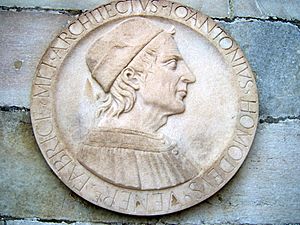
In 1488, famous artists Leonardo da Vinci and Donato Bramante made models for the central dome. Leonardo later pulled his design. From 1500 to 1510, the octagonal dome was finished. Inside, it was decorated with 60 statues of saints, prophets, and other Bible figures. The outside of the dome stayed plain for a long time. The only decoration was the Guglietto dell'Amadeo (Amadeo's Little Spire), built from 1507 to 1510. This was a Renaissance artwork that fit well with the church's Gothic look.
During the time Spain ruled Milan, the church was used, even though much of the inside was not finished. In 1552, a large organ was built. In 1562, the famous statue of St. Bartholomew by Marco d'Agrate was added. The old Trivulzio candelabrum from the 12th century was also placed there.
Borromeo's Influence
When Carlo Borromeo became archbishop, he had all non-religious monuments removed from the Duomo. This included the tombs of several Visconti and Sforza rulers. Borromeo also hired Pellegrino Pellegrini as the chief engineer in 1571. This was a big change because Pellegrini was not a church member.
Borromeo and Pellegrini wanted the cathedral to look more like a Renaissance building. They wanted to show its Italian style and make the Gothic style less noticeable. The front of the church was still mostly unfinished. So, Pellegrini designed a "Roman" style front with columns and a large tympanum. This design was never built, but work on the inside continued. From 1575 to 1585, the presbytery was rebuilt. New altars and a baptistry were added. In 1577, Borromeo officially made the building a new church.
17th and 18th Century Changes
In the early 1600s, Federico Borromeo started building the new front of the cathedral. Work continued until 1638, with five doorways and two windows being built. But in 1649, the new chief architect, Carlo Buzzi, made a big change. He decided the front should go back to the original Gothic style. Other designs were suggested, but none were used. In 1682, the old Santa Maria Maggiore church was taken down. The cathedral's roof was finally finished.
In 1762, a very important part of the cathedral was built: the Madonnina's spire. It reaches a height of 108.5 meters (356 feet). The spire was designed by Carlo Pellicani. At its very top is a famous gold statue of the Madonnina, designed by Giuseppe Perego. Milan is often foggy, so people consider it a good day when they can see the Madonnina from far away.
Finishing the Cathedral
[[File:Sanquirico-design-for-crowning-of-Ferdinand I of Austria at the Duomo in 1838, by Alessandro Sanquirico]] On May 20, 1805, Napoleon Bonaparte ordered the front of the cathedral to be finished. He was about to be crowned King of Italy. He promised that the French government would pay for everything. Even though the money was never fully paid, the cathedral's front was completed in just seven years. Pellicani mostly followed Buzzi's plan, adding some new Gothic details. A statue of Napoleon was placed on top of one of the spires as a thank you. Napoleon was crowned King of Italy right there in the Duomo.
In the years that followed, most of the missing arches and spires were built. The statues on the south wall were also finished. From 1829 to 1858, new stained glass windows replaced the old ones. The very last details of the cathedral were finished in the 20th century. The last doorway was opened on January 6, 1965. This date is seen as the end of a building process that lasted for generations. Even today, some stone blocks are still waiting to be carved into statues.
Allied bombing of Milan in World War II caused some damage to the Duomo. However, it was less damaged than other big buildings nearby. It was quickly repaired and became a place where local people could find comfort.
The main front of the Duomo was renovated from 2003 to early 2009. By February 2009, it was fully uncovered. It once again showed the beautiful colors of the Candoglia marble.
In 2012, officials started a campaign to raise money for the cathedral. They asked people to "adopt" the building's spires. Pollution affects the 14th-century building, so it needs regular care. Italy's budget cuts meant less money for cultural places like the cathedral. To help, the Duomo management offered its 135 spires for "adoption." Donors who give €100,000 (about $110,505) or more get a plaque with their name on a spire.
Architecture and Art
The cathedral's design includes a main nave with four side aisles. These are crossed by a transept, followed by the choir and apse. The nave is about 45 meters (148 feet) high. It has the tallest Gothic vaults in any completed church.
You can visit the roof of the cathedral for a fee. This lets you see many amazing sculptures up close. The roof is famous for its many openwork pinnacles and spires. These are set on delicate flying buttresses.
The cathedral has five wide naves, separated by 40 pillars. These are reflected in the openings on the front of the building. Even the transepts have aisles. The columns in the nave are 24.5 meters (80 feet) high. The windows in the apse are 20.7 by 8.5 meters (68 by 28 feet). The building is made of brick, covered with marble from the Candoglia quarries. These quarries were given to the cathedral forever by Gian Galeazzo Visconti. Keeping the cathedral in good shape is very complex.
In 2015, Milan's cathedral got a new lighting system using LEDs.
Famous Views and Opinions
The cathedral was built over many centuries. Because of this, it has different styles. People have had different feelings about it, from loving it to not liking it. Early Romantics often praised it when they first became interested in Gothic style. But as tastes changed, people sometimes strongly disliked it.
John Ruskin, a famous writer, said the cathedral took from "every style in the world: and every style spoiled." He thought the statues were "of the worst possible common stonemasons’ yard species." He also disliked the painted ceiling that looked like carved stone.
However, Henry James, another writer, was more positive. He called it "a structure not supremely interesting, not logical, not … commandingly beautiful, but grandly curious and superbly rich." He saw it as "a supreme embodiment of vigorous effort."
Mark Twain, an American writer, visited Milan in 1867. He wrote about the Duomo in his book Innocents Abroad. He described it as "So grand, so solemn, so vast! And yet so delicate, so airy, so graceful!" He was amazed by the detailed carvings on the doors and the many statues. He said, "everywhere that a niche or a perch can be found about the enormous building, from summit to base, there is a marble statue." He thought it was second only to St. Peter's in Rome.
Oscar Wilde visited Milan in 1875. He wrote to his mother that "The Cathedral is an awful failure. Outside the design is monstrous and inartistic." But he also said it was "imposing and gigantic as a failure, through its great size and elaborate execution."
Main Artworks and Features
The inside of the cathedral has many important artworks and monuments. Here are some of them:
- On the left side of the altar is the most famous statue in the cathedral. It is Saint Bartholomew Flayed (1562) by Marco d'Agrate.
- The tomb of Archbishop Alberto da Intimiano. Above it is a copper crucifix.
- The tombs of Archbishops Ottone Visconti and Giovanni Visconti. These were made by a master from Campione in the 14th century.
- The tomb of Marco Carelli, who gave a lot of money to help build the cathedral.
- Three beautiful altars by Pellegrino Pellegrini. These include a painting by Federico Zuccari showing St. Peter visiting St. Agatha in jail.
- In the right transept, there is a monument to Gian Giacomo Medici di Marignano. It was made by Leone Leoni. Next to it is a Renaissance marble altar with gold bronze statues.
- The presbytery is a masterpiece from the late Renaissance. It has a choir, a temple by Pellegrini, and two pulpits. These pulpits have giant atlantes covered in copper and bronze. There are also two large organs.
- In the transepts, you can see the Trivulzio Candelabrum. It has two parts. The base, from the 12th century, has amazing carvings of plants and animals. The top part is from the mid-16th century.
- In the left aisle, there is the Arcimboldi monument. There are also Romanesque figures of the Apostles made of red marble. You can also see the new Classic baptistry by Pellegrini.
- A small red light bulb in the dome above the apse shows where one of the nails from the Crucifixion of Christ is believed to be kept. This Holy Nail is taken out and shown to the public every year. This event is called the Rite of the Nivola.
- In November and December, around the birthday of Saint Charles Borromeo, large paintings called the Quadroni are displayed along the nave.
- Since 2005, there has been a video art piece in the cathedral's crypt. It is by English artist Mark Wallinger. It is an 18-minute film showing scenes from the Passion of Christ.
- In 2014, a white marble sculpture by Tony Cragg was put in place. It was inspired by the Madonna statue on the roof.
- The cathedral has a huge pipe organ with 5 keyboards and 225 ranks. It was built by Italian companies Tamburini and Mascioni. It is currently the largest organ in all of Italy.
Astronomical Observations
On December 1, 1786, the Austrian Empire started using a new time system. Astronomers from the Brera Astronomical Observatory were asked to build a meridian line inside the Duomo. This line was built by Giovanni Angelo Cesaris and Francesco Reggio.
The meridian line was placed on the floor at the west end of the Duomo. This made it easy to reach and kept it from getting in the way of church services. A hole was made in the roof near the south wall, 24 meters (79 feet) high. The Duomo is not quite wide enough for a hole at this height. So, the meridian line goes up the north wall for about 3 meters (10 feet).
When the beam of light crossed the brass line, it showed solar noon. A signal was then sent to the tower of the Palazzo dei Giureconsulti. A person there would alert Sforzesco Castle. Then, a cannon was fired to tell the city it was solar noon. This signal was used to set all the city clocks to the same time.
In 1976, the line was checked by architects and astronomers. There were small errors, but the line was still accurate enough to tell solar noon within 2 seconds.
Images for kids
See also
 In Spanish: Catedral de Milán para niños
In Spanish: Catedral de Milán para niños


